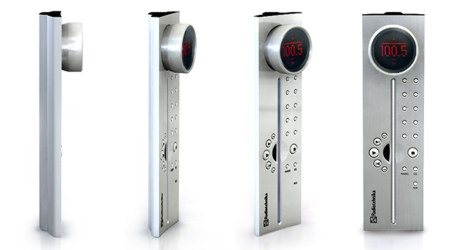|
Artemy Lebedev
§ 76. Two major principles of interface buildingDecember 21, 2001 |
|
In terms of the method of control, Radiotehnika R-100 is essentially different from all stereo systems available on today’s market. |
 |
|
Art. Lebedev Studio developed a concept of two identical radio remote controls, each capable to perform both as a remote control and the stereo system’s control panel. |
|
With the traditional format (that all other stereo systems have) there’s a substantial difference between the remote control and the object of control. Of course, not only their exteriors differ: it’s primarily about interfaces that don’t look the same. |
|
The ideology of R-100 control is built on two basic principles that the studio employs throughout its interface development projects. |
|
1. Unity of form—unity of content |
|
And what if the elements of control of the same function have a totally different look? The audio volume control may de designed as a round knob, while on the remote control the same function is implemented by two buttons. It’s not just about the lack of comfort—it’s also a source of lots of psychological difficulties, since the user cannot develop his motor memory. |
|
In R-100 this problem was completely solved. |
 |
|
2. Feedback |
|
We can increase the sound volume say of an amplifier using a remote control. The volume indicator on the amplifier will change its status, but it will not be reflected on the remote control. Moreover: owing to the producer’s problems with interface, control elements have to be made discrete (for example, the “volume+” and “volume−” buttons instead of a single volume regulator). |
|
Now let’s imagine we have the same handle to smoothly adjust the sound volume both on the object and on the remote control. We shield the infrared port with a palm and adjust the volume. Nothing changes in the object. What happens after we remove the palm from the port? Which of indicator statuses—the one of the remote control or the object’s— will be the one of priority? Will the sound volume grow or sink to the position indicated on the remote control? Producers are currently tackling this problem by introducing discrete control elements. Therefore when you select track 5 on your remote control, the object’s signal lamp turns on, while the remote control remains as it was. |
|
In R-100 we have also found a complete solution to this problem: the feedback proceeds via a radio channel on an on-going basis. |
 |
|
Both interface building principles described above are applicable to hardware and software alike. |
|
Consistency, predictability and similarity in performance of a control element should be present throughout the entire system. Still better—throughout all systems. If you adjust the volume using a dial, it should be a dial everywhere—not buttons, levers, rollers etc. That’s why one should avoid devising non-standard control elements for websites if there are system tools. The user knows a dozen interface elements of his own operating system and is reluctant to learn new means of control just because your website is equipped with them. |
|
Two-way feedback systems are of prime importance not only for electronics, but also for software interface building. Once you’ve changed the volume on one panel, the volume indicator status should be updated on all other panels. If panels can be seen simultaneously, these changes should also take place simultaneously for the user to see them happen. |
|
|
|